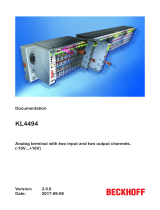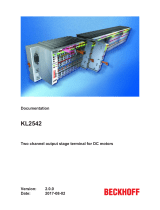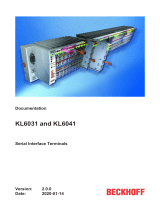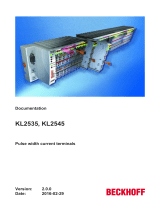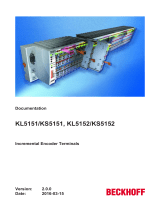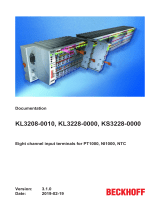Page is loading ...

Documentation
KL6781
M-Bus Master Terminals
2.0.0
2018-01-16
Version:
Date:


Table of contents
KL6781 3Version: 2.0.0
Table of contents
1 Foreword ....................................................................................................................................................5
1.1 Notes on the documentation........................................................................................................... 5
1.2 Safety instructions .......................................................................................................................... 6
1.3 Documentation Issue Status........................................................................................................... 7
2 Product overview.......................................................................................................................................8
2.1 Introduction ..................................................................................................................................... 8
2.2 Technical data of the KL6781 ......................................................................................................... 9
2.3 LED displays................................................................................................................................. 10
3 Mounting and wiring ...............................................................................................................................11
3.1 Installation on mounting rails ........................................................................................................ 11
3.2 Installation instructions for enhanced mechanical load capacity .................................................. 13
3.3 Connection.................................................................................................................................... 14
3.3.1 Connection system...........................................................................................................14
3.3.2 Wiring...............................................................................................................................16
3.3.3 Connection.......................................................................................................................17
4 Access from the user program ..............................................................................................................18
4.1 Register Overview ........................................................................................................................ 18
4.2 Control and status word................................................................................................................ 19
4.3 Process image .............................................................................................................................. 21
4.4 Mapping ........................................................................................................................................ 22
4.5 Register description ...................................................................................................................... 23
4.6 Examples of Register Communication.......................................................................................... 25
4.6.1 Example 1: reading the firmware version from Register 9 ...............................................25
4.6.2 Example 2: Writing to an user register.............................................................................25
5 M-bus ........................................................................................................................................................28
5.1 Introduction ................................................................................................................................... 28
5.2 Overview....................................................................................................................................... 28
5.3 Topology ....................................................................................................................................... 29
6 Programming ...........................................................................................................................................30
6.1 TwinCAT libraries ......................................................................................................................... 30
7 Appendix ..................................................................................................................................................31
7.1 Support and Service ..................................................................................................................... 31

Table of contents
KL67814 Version: 2.0.0

Foreword
KL6781 5Version: 2.0.0
1 Foreword
1.1 Notes on the documentation
Intended audience
This description is only intended for the use of trained specialists in control and automation engineering who
are familiar with the applicable national standards.
It is essential that the documentation and the following notes and explanations are followed when installing
and commissioning these components.
It is the duty of the technical personnel to use the documentation published at the respective time of each
installation and commissioning.
The responsible staff must ensure that the application or use of the products described satisfy all the
requirements for safety, including all the relevant laws, regulations, guidelines and standards.
Disclaimer
The documentation has been prepared with care. The products described are, however, constantly under
development.
We reserve the right to revise and change the documentation at any time and without prior announcement.
No claims for the modification of products that have already been supplied may be made on the basis of the
data, diagrams and descriptions in this documentation.
Trademarks
Beckhoff
®
, TwinCAT
®
, EtherCAT
®
, Safety over EtherCAT
®
, TwinSAFE
®
, XFC
®
and XTS
®
are registered
trademarks of and licensed by Beckhoff Automation GmbH.
Other designations used in this publication may be trademarks whose use by third parties for their own
purposes could violate the rights of the owners.
Patent Pending
The EtherCAT Technology is covered, including but not limited to the following patent applications and
patents: EP1590927, EP1789857, DE102004044764, DE102007017835 with corresponding applications or
registrations in various other countries.
The TwinCAT Technology is covered, including but not limited to the following patent applications and
patents: EP0851348, US6167425 with corresponding applications or registrations in various other countries.
EtherCAT
®
is registered trademark and patented technology, licensed by Beckhoff Automation GmbH,
Germany
Copyright
© Beckhoff Automation GmbH & Co. KG, Germany.
The reproduction, distribution and utilization of this document as well as the communication of its contents to
others without express authorization are prohibited.
Offenders will be held liable for the payment of damages. All rights reserved in the event of the grant of a
patent, utility model or design.

Foreword
KL67816 Version: 2.0.0
1.2 Safety instructions
Safety regulations
Please note the following safety instructions and explanations!
Product-specific safety instructions can be found on following pages or in the areas mounting, wiring,
commissioning etc.
Exclusion of liability
All the components are supplied in particular hardware and software configurations appropriate for the
application. Modifications to hardware or software configurations other than those described in the
documentation are not permitted, and nullify the liability of Beckhoff Automation GmbH & Co. KG.
Personnel qualification
This description is only intended for trained specialists in control, automation and drive engineering who are
familiar with the applicable national standards.
Description of symbols
In this documentation the following symbols are used with an accompanying safety instruction or note. The
safety instructions must be read carefully and followed without fail!
DANGER
Serious risk of injury!
Failure to follow the safety instructions associated with this symbol directly endangers the
life and health of persons.
WARNING
Risk of injury!
Failure to follow the safety instructions associated with this symbol endangers the life and
health of persons.
CAUTION
Personal injuries!
Failure to follow the safety instructions associated with this symbol can lead to injuries to
persons.
Attention
Damage to the environment or devices
Failure to follow the instructions associated with this symbol can lead to damage to the en-
vironment or equipment.
Note
Tip or pointer
This symbol indicates information that contributes to better understanding.

Foreword
KL6781 7Version: 2.0.0
1.3 Documentation Issue Status
Version Comment
2.0.0 • Migration
1.4.0
• Programming description moved to the TwinCAT Information System [}30].
• Library updated to version 2.0.1
• Technical data updated
1.3.0 • Function block FB_MBUS_SBC_ALD1 added
• Library updated to version 120
1.2.0 • Programming chapter updated
1.1.0 • Foreword updated
• Mounting instructions extended
• Description of control and status word expanded
• Register description extended
• M-bus chapter added
• Programming chapter extended
1.0.0 • First release
Firmware and hardware versions
Documentation
Version
KL6781
Firmware Hardware
2.0.0 1C 03
1.4.0 1B 01
1.3.0 1B 01
1.2.0 1B 01
1.1.0 1B 01
1.0.0 1A 00
The firmware and hardware versions (delivery state) can be found in the serial number printed on the side of
the terminal.
Syntax of the serial number
Structure of the serial number: KKYYFFHH
KK - week of production (CW, calendar week)
YY - year of production
FF - firmware version
HH - hardware version
Example with ser. no.: 50 11 1A 00:
50 - week of production 50
11- year of production 2011
1A - firmware version 1A
00 - hardware version 00

Product overview
KL67818 Version: 2.0.0
2 Product overview
2.1 Introduction
Fig.1: KL6781
The KL6781 M-bus master terminal enables direct connection of M-Bus devices. The M-bus (meter bus) is a
fieldbus for consumption data acquisition from electricity, water, gas or energy meters.
The KL6781 does not contain the M-bus protocol but converts the K-bus data to an M-bus compliant format.
On the K-bus, 24bytes are available for this purpose for each M-bus master terminal.
The TwinCAT M-bus library enables operation without external M-bus gateway, i.e. the M-bus devices can
be connected directly to the KL6781.
With a total line length of 300m, up to 40M-bus devices can be operated at a KL6781.

Product overview
KL6781 9Version: 2.0.0
2.2 Technical data of the KL6781
Technical Data KL6781
Data transfer channels 1
M-bus devices max. 40
Transmission standard M-bus properties
Data transfer rate 300...9600baud (default 2,400baud)
Bus access Master-slave technique (polling)
Cable length max. 300m
Current consumption from the K-bus typically 65mA
Current consumption from power contacts max. 250mA
Short-circuit strength yes
Electrical isolation 500V (K-bus/ M-bus)
Width in the process image input/output: 24bytes
Configuration TwinCAT PLC (M-bus function blocks)
Rated voltage 24V
DC
(-15%/ +20%)
Input voltage 24V
DC
(-15%/ +20%)
Weight approx. 60g
Mounting [}11]
on 35mm mounting rail conforms to EN60715
Permissible ambient temperature range during
operation
0 °C ... +55 °C
Permissible ambient temperature range during storage -25 °C ... +85 °C
Permissible relative humidity 95%, no condensation
Vibration/shock resistance conforms to EN60068-2-6/ EN60068-2-27
see also installation instructions [}13] for
terminals with enhanced mechanical load capacity
EMC immunity/emission conforms to EN61000-6-2/ EN61000-6-4
Protection class IP20
Installation position variable
Approval CE, UL

Product overview
KL678110 Version: 2.0.0
2.3 LED displays
Fig.2: LEDs
LED Color Meaning
Run green This LED indicates the terminal's operating state:
on Normal operation
off The RUN LED goes out if no process data is transmitted to the terminal from the Bus
Coupler for 100 ms.
Error red General error is signaled
Send green Data transmission on the M-bus
Receive green Data transmission on the M-bus

Mounting and wiring
KL6781 11Version: 2.0.0
3 Mounting and wiring
3.1 Installation on mounting rails
WARNING
Risk of electric shock and damage of device!
Bring the bus terminal system into a safe, powered down state before starting installation,
disassembly or wiring of the Bus Terminals!
Assembly
Fig.3: Attaching on mounting rail
The Bus Coupler and Bus Terminals are attached to commercially available 35mm mounting rails (DIN rails
according to EN60715) by applying slight pressure:
1. First attach the Fieldbus Coupler to the mounting rail.
2. The Bus Terminals are now attached on the right-hand side of the Fieldbus Coupler. Join the compo-
nents with tongue and groove and push the terminals against the mounting rail, until the lock clicks
onto the mounting rail.
If the Terminals are clipped onto the mounting rail first and then pushed together without tongue and
groove, the connection will not be operational! When correctly assembled, no significant gap should
be visible between the housings.
Note
Fixing of mounting rails
The locking mechanism of the terminals and couplers extends to the profile of the mounting
rail. At the installation, the locking mechanism of the components must not come into con-
flict with the fixing bolts of the mounting rail. To mount the mounting rails with a height of
7.5mm under the terminals and couplers, you should use flat mounting connections (e.g.
countersunk screws or blind rivets).

Mounting and wiring
KL678112 Version: 2.0.0
Disassembly
Fig.4: Disassembling of terminal
Each terminal is secured by a lock on the mounting rail, which must be released for disassembly:
1. Pull the terminal by its orange-colored lugs approximately 1cm away from the mounting rail. In doing
so for this terminal the mounting rail lock is released automatically and you can pull the terminal out of
the bus terminal block easily without excessive force.
2. Grasp the released terminal with thumb and index finger simultaneous at the upper and lower grooved
housing surfaces and pull the terminal out of the bus terminal block.
Connections within a bus terminal block
The electric connections between the Bus Coupler and the Bus Terminals are automatically realized by
joining the components:
• The six spring contacts of the K-Bus/E-Bus deal with the transfer of the data and the supply of the Bus
Terminal electronics.
• The power contacts deal with the supply for the field electronics and thus represent a supply rail within
the bus terminal block. The power contacts are supplied via terminals on the Bus Coupler (up to 24V)
or for higher voltages via power feed terminals.
Note
Power Contacts
During the design of a bus terminal block, the pin assignment of the individual Bus Termi-
nals must be taken account of, since some types (e.g. analog Bus Terminals or digital 4-
channel Bus Terminals) do not or not fully loop through the power contacts. Power Feed
Terminals (KL91xx, KL92xx or EL91xx, EL92xx) interrupt the power contacts and thus rep-
resent the start of a new supply rail.
PE power contact
The power contact labeled PE can be used as a protective earth. For safety reasons this contact mates first
when plugging together, and can ground short-circuit currents of up to 125A.

Mounting and wiring
KL6781 13Version: 2.0.0
Fig.5: Power contact on left side
Attention
Possible damage of the device
Note that, for reasons of electromagnetic compatibility, the PE contacts are capacitatively
coupled to the mounting rail. This may lead to incorrect results during insulation testing or
to damage on the terminal (e.g. disruptive discharge to the PE line during insulation testing
of a consumer with a nominal voltage of 230V). For insulation testing, disconnect the PE
supply line at the Bus Coupler or the Power Feed Terminal! In order to decouple further
feed points for testing, these Power Feed Terminals can be released and pulled at least
10mm from the group of terminals.
WARNING
Risk of electric shock!
The PE power contact must not be used for other potentials!
3.2 Installation instructions for enhanced mechanical load
capacity
WARNING
Risk of injury through electric shock and damage to the device!
Bring the Bus Terminal system into a safe, de-energized state before starting mounting,
disassembly or wiring of the Bus Terminals!
Additional checks
The terminals have undergone the following additional tests:
Verification Explanation
Vibration 10 frequency runs in 3 axes
6 Hz < f < 60 Hz displacement 0.35 mm, constant amplitude
60.1Hz<f<500Hz acceleration 5g, constant amplitude
Shocks 1000 shocks in each direction, in 3 axes
25 g, 6 ms

Mounting and wiring
KL678114 Version: 2.0.0
Additional installation instructions
For terminals with enhanced mechanical load capacity, the following additional installation instructions apply:
• The enhanced mechanical load capacity is valid for all permissible installation positions
• Use a mounting rail according to EN 60715 TH35-15
• Fix the terminal segment on both sides of the mounting rail with a mechanical fixture, e.g. an earth
terminal or reinforced end clamp
• The maximum total extension of the terminal segment (without coupler) is:
64 terminals (12 mm mounting with) or 32 terminals (24 mm mounting with)
• Avoid deformation, twisting, crushing and bending of the mounting rail during edging and installation of
the rail
• The mounting points of the mounting rail must be set at 5 cm intervals
• Use countersunk head screws to fasten the mounting rail
• The free length between the strain relief and the wire connection should be kept as short as possible. A
distance of approx. 10 cm should be maintained to the cable duct.
3.3 Connection
3.3.1 Connection system
WARNING
Risk of electric shock and damage of device!
Bring the bus terminal system into a safe, powered down state before starting installation,
disassembly or wiring of the Bus Terminals!
Overview
The Bus Terminal system offers different connection options for optimum adaptation to the respective
application:
• The terminals of ELxxxx and KLxxxx series with standard wiring include electronics and connection
level in a single enclosure.
• The terminals of ESxxxx and KSxxxx series feature a pluggable connection level and enable steady
wiring while replacing.
• The High Density Terminals (HD Terminals) include electronics and connection level in a single
enclosure and have advanced packaging density.
Standard wiring (ELxxxx / KLxxxx)
Fig.6: Standard wiring
The terminals of ELxxxx and KLxxxx series have been tried and tested for years.
They feature integrated screwless spring force technology for fast and simple assembly.

Mounting and wiring
KL6781 15Version: 2.0.0
Pluggable wiring (ESxxxx / KSxxxx)
Fig.7: Pluggable wiring
The terminals of ESxxxx and KSxxxx series feature a pluggable connection level.
The assembly and wiring procedure is the same as for the ELxxxx and KLxxxx series.
The pluggable connection level enables the complete wiring to be removed as a plug connector from the top
of the housing for servicing.
The lower section can be removed from the terminal block by pulling the unlocking tab.
Insert the new component and plug in the connector with the wiring. This reduces the installation time and
eliminates the risk of wires being mixed up.
The familiar dimensions of the terminal only had to be changed slightly. The new connector adds about 3
mm. The maximum height of the terminal remains unchanged.
A tab for strain relief of the cable simplifies assembly in many applications and prevents tangling of individual
connection wires when the connector is removed.
Conductor cross sections between 0.08mm
2
and 2.5mm
2
can continue to be used with the proven spring
force technology.
The overview and nomenclature of the product names for ESxxxx and KSxxxx series has been retained as
known from ELxxxx and KLxxxx series.
High Density Terminals (HD Terminals)
Fig.8: High Density Terminals
The Bus Terminals from these series with 16 terminal points are distinguished by a particularly compact
design, as the packaging density is twice as large as that of the standard 12mm Bus Terminals. Massive
conductors and conductors with a wire end sleeve can be inserted directly into the spring loaded terminal
point without tools.
Note
Wiring HD Terminals
The High Density (HD) Terminals of the ELx8xx and KLx8xx series doesn't support plug-
gable wiring.
Ultrasonically "bonded" (ultrasonically welded) conductors
Note
Ultrasonically “bonded" conductors
It is also possible to connect the Standard and High Density Terminals with ultrasonically
"bonded" (ultrasonically welded) conductors. In this case, please note the tables concern-
ing the wire-size width below!

Mounting and wiring
KL678116 Version: 2.0.0
3.3.2 Wiring
WARNING
Risk of electric shock and damage of device!
Bring the bus terminal system into a safe, powered down state before starting installation,
disassembly or wiring of the Bus Terminals!
Terminals for standard wiring ELxxxx/KLxxxx and for pluggable wiring ESxxxx/KSxxxx
Fig.9: Connecting a cable on a terminal point
Up to eight terminal points enable the connection of solid or finely stranded cables to the Bus Terminal. The
terminal points are implemented in spring force technology. Connect the cables as follows:
1. Open a terminal point by pushing a screwdriver straight against the stop into the square opening
above the terminal point. Do not turn the screwdriver or move it alternately (don't toggle).
2. The wire can now be inserted into the round terminal opening without any force.
3. The terminal point closes automatically when the pressure is released, holding the wire securely and
permanently.
See the following table for the suitable wire size width.
Terminal housing ELxxxx, KLxxxx ESxxxx, KSxxxx
Wire size width (single core wires) 0.08 ... 2.5mm
2
0.08 ... 2.5mm
2
Wire size width (fine-wire conductors) 0.08 ... 2.5mm
2
0,08 ... 2.5mm
2
Wire size width (conductors with a wire end sleeve) 0.14 ... 1.5mm
2
0.14 ... 1.5mm
2
Wire stripping length 8 ... 9mm 9 ... 10mm
High Density Terminals (HD Terminals [
}
15]) with 16 terminal points
The conductors of the HD Terminals are connected without tools for single-wire conductors using the direct
plug-in technique, i.e. after stripping the wire is simply plugged into the terminal point. The cables are
released, as usual, using the contact release with the aid of a screwdriver. See the following table for the
suitable wire size width.

Mounting and wiring
KL6781 17Version: 2.0.0
Terminal housing High Density Housing
Wire size width (single core wires) 0.08 ... 1.5mm
2
Wire size width (fine-wire conductors) 0.25 ... 1.5mm
2
Wire size width (conductors with a wire end sleeve) 0.14 ... 0.75mm
2
Wire size width (ultrasonically “bonded" conductors) only 1.5mm
2
Wire stripping length 8 ... 9mm
3.3.3 Connection
Fig.10: Connection
Terminal point Name Signal
1 reserved -
2 M-bus+ M-bus plus, internally connected to terminal point6
3 M-bus- M-bus minus, internally connected to terminal point7
4 Shield Shield connection, internally connected to terminal
point8
5 reserved -
6 M-bus+ M-bus plus, internally connected to terminal point2
7 M-bus- M-bus minus, internally connected to terminal point3
8 Shield Shield connection, internally connected to terminal
point4

Access from the user program
KL678118 Version: 2.0.0
4 Access from the user program
4.1 Register Overview
The registers are used for parameterization the M-bus master terminal. They can be read or written by
means of the register communication [}25].
Register no. Comment Default value R/W Memory
R0 [}23]
Number of data bytes in the send buffer variable variable R RAM
R1 [}23]
Number of data bytes in the receive buffer variable variable R RAM
R2 Number of parity errors 0x0000 0
dec
R -
R3 Number of framing errors 0x0000 0
dec
R -
R4 reserved 0x0000 0
dec
R -
R5 reserved 0x0000 0
dec
R -
R6 [}23]
Diagnostic register variable variable R RAM
R7 [}23]
Command register 0x0000 0
dec
R/W RAM
R8 [}23]
Terminal type 0x1A7D 6781
dec
R ROM
R9 [}24]
Firmware version variable variable R ROM
R10 reserved 0x0000 0
dec
- -
... ... ... ... ... ...
R15 reserved 0x0000 0
dec
- -
R16 Hardware version e.g.0x0000 e.g.: 0
dec
... EEPROM
R17 reserved 0x0000 0
dec
- -
... ... ... ... ... ...
R18 reserved 0x0000 0
dec
- -
R29 [}24]
Terminal type - special identification 0x0000 0
dec
R EEPROM
R30 reserved 0x0000 0
dec
R/W RAM
R31 [}24]
Code word register 0x0000 0
dec
R/W RAM
R32 [}24]
Baud rate register 0x0004 4
dec
R/W EEPROM
R33 reserved 0x0000 0
dec
R/W -
... ... ... ... ... ...
R63 reserved 0x0000 0
dec
R/W -

Access from the user program
KL6781 19Version: 2.0.0
4.2 Control and status word
Process data mode
Control word (in process data mode)
The control word (CW) is located in the output process image [}21], and is transmitted from the controller
to the terminal.
Bit CW.15 CW.14 CW.13 CW.12 CW.11 CW.10 CW.9 CW.8 CW.7 CW.6 CW.5 CW.4 CW.3 CW.2 CW.1 CW.0
Name OL7 OL6 OL5 OL4 OL3 OL2 OL1 OL0 Reg - - - - IR RA TR
Key
Bit Name Description
CW.15...CW.
8
OL7... OL0
(OutLenght)
1
dec
...
22
dec
Number of output bytes () available for transfer from the
controller to the terminal.
CW.7 Reg (RegAccess) 0
bin
Register communication off (process data mode)
CW.6...CW.3 - 0
bin
reserved
CW.2 IR
(InitRequest)
0
bin
The controller once again requests the terminal to prepare for
serial data exchange.
1
bin
The controller requests terminal for initialization. The
transmission and reception functions are disabled, the FIFO
pointers are reset and the interface is initialized with the
values in the appropriate registers. The terminal
acknowledges completion of the initialization via bit SW.2
[}19] (IA).
CW.1 RA
(ReceiveAccepted)
toggle The controller acknowledges receipt of data by changing the
state of this bit. Only then new data can be transferred from
the terminal to the controller.
CW.0 TR
(TransmitRequest)
toggle Via a change of state of this bit the controller notifies the
terminal that the DataOut bytes contain the number of bytes
indicated via the OL bits. The terminal acknowledges receipt
of the data in the status byte via a change of state of bit SW.0
[}19] (TA). Only now new data can be transferred from the
controller to the terminal.
Status word (in process data mode)
The status word (SW) is located in the input process image [}21], and is transmitted from terminal to the
controller.
Bit SW.15 SW.14 SW.13 SW.12 SW.11 SW.10 SW.9 SW.8 SW.7 SW.6 SW.5 SW.4 SW.3 SW.2 SW.1 SW.0
Name IL7 IL6 IL5 IL4 IL3 IL2 IL1 IL0 Reg - - - BUF_F IA RR TA

Access from the user program
KL678120 Version: 2.0.0
Key
Bit Name Description
SW.15...SW8 IL7... IL0
(InLength)
1
dec
...
22
dec
Number of input bytes available for transfer from the terminal
to the controller.
SW.7 Reg (RegAccess) 0
bin
Acknowledgment for process data mode
SW.6...SW.4 - 0 reserved
SW.3 BUF_F 1
bin
The reception FIFO is full. All further incoming data will be
lost!
SW.2 IA
(InitAccepted bit)
1
bin
Initialization was completed by the terminal.
0
bin
The terminal is ready again for serial data exchange.
SW.1 RR
(ReceiveRequest)
toggle Via a change of state of this bit the terminal notifies the
controller that the DataIn bytes contain the number of bytes
indicated via the IL bits. The controller has to acknowledge
receipt of the data in the control byte via a change of state of
bit CW.1 [}19] (RA). Only then new data can be transferred
from the terminal to the controller.
SW.0 TA
(TransmitAccepted)
toggle The terminal acknowledges receipt of data by changing the
state of this bit. Only then new data can be transferred from
the terminal to the controller
Register communication
Control word (in register communication)
The control word (CW) is located in the output process image [}21], and is transmitted from the controller
to the terminal.
Bit CW.15 CW.14 CW.13 CW.12 CW.11 CW.10 CW.9 CW.8 CW.7 CW.6 CW.5 CW.4 CW.3 CW.2 CW.1 CW.0
Name RegData: Reg R/W Reg. no.
Key
Bit Name Description
CW.15...CW.
8
RegData: One byte of data to be written to the register. The other byte is
transferred in the adjacent process data byte.
CW.7 Reg 1
bin
Register communication switched on
CW.6 R/W 0
bin
Read access
1
bin
Write access
CW.5 to CW.0 Reg. no. Register number:
Enter the number of the register [}18] that you want to
- read with the input data word DataIN [}21] and the HighByte of the
status bytes (RegData) or
- write the output data wordDataOUT [}21] and the HighByte of
control word (RegData).
Status byte (for register communication)
The status word (SW) is located in the input process image [}21], and is transmitted from terminal to the
controller.
Bit SW.15 SW.14 SW.13 SW.12 SW.11 SW.10 SW.9 SW.8 SW.7 SW.6 SW.5 SW.4 SW.3 SW.2 SW.1 SW.0
Name RegData: Reg R/W Reg. no.
/


